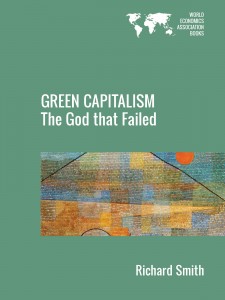Ref Real World Economics Review Blog/May 2015/Blogger Ref
http://www.p2pfoundation.net/Transfinancial_Economics
When, on May 10th 2013 scientists at Mauna Loa Observatory on the big island of Hawaii announced that global CO2 emissions had crossed a threshold at 400 parts per million (ppm) for the first time in millions of years, a sense of dread spread around the world and not only among climate scientists. CO2 emissions have been relentlessly climbing since Charles David Keeling first set up his tracking station near the summit of Mauna Loa Observatory in 1958 to monitor average daily global CO2 levels. At that time, CO2 concentrations registered 315ppm. CO2 emissions and atmospheric concentrations have been relentlessly climbing ever since and, as the records show, temperatures rises will follow. For all the climate summits, the promises of “voluntary restraint,” the carbon trading and carbon taxes, the growth of CO2 emissions and atmospheric concentrations has not just been relentless, it has been accelerating in what scientists have dubbed the “Keeling Curve.” In the early 1960s, CO2ppm concentrations in the atmosphere grew by 0.7ppm per year. In recent decades, especially as China has industrialized, the growth rate has tripled to 2.1ppm per year. In just the first 17 weeks of 2013, CO2 levels jumped by 2.74ppm compared to last year – “the biggest increase since benchmark monitoring stations high on the Hawaiian volcano of Mauna Loa began taking measurements in 1958.”1 Carbon concentrations have not been this high since the Pliocene period, between 3m and 5m years ago, when global average temperatures were 3 or 4˚C hotter than today, the Arctic was ice-free, sea levels were about 40m higher, jungles covered northern Canada, while Florida was under water, along with coastal locations we now call New York city, London, Shanghai, Hong Kong, Sydney and many others.
Crossing this threshold has fueled fears that we are fast approaching “tipping points” – melting of the subarctic tundra or thawing and releasing the vast quantities of methane in the Arctic sea bottom – that will accelerate global warming beyond any human capacity to stop it. Scripps Institute geochemist Ralph Keeling whose father Charles Keeling set up the first monitoring stations in 1958 said:
At this pace, we’ll hit 450 ppm within a few decades.”
“It feels like the inevitable march toward disaster,” said Maureen E. Raymo, a scientist at the Lamont-Doherty Earth Observatory, a unit of Columbia University.”
Why are we marching to disaster, “sleepwalking to extinction” as the Guardian’s George Monbiot once put it? Why can’t we slam on the brakes before we ride off the cliff to collapse? I’m going to argue here that the problem is rooted in the requirements of capitalist reproduction, that large corporations are destroying life on earth, that they can’t help themselves, they can’t change or change very much, that so long as we live under this system we have little choice but to go along in this destruction, to keep pouring on the gas instead of slamming on the brakes, and that the only alternative – impossible as this may seem right now – is to overthrow this global economic system and all of the governments of the 1% that prop it up, and replace them with a global economic democracy, a radical bottom-up political democracy, an ecosocialist civilization. I argue that, although we are fast approaching the precipice of ecological collapse, the means to derail this trainwreck are in the making as, around the world we are witnessing a near simultaneous global mass democratic “awakening” as the Brazilians call it, almost a global uprising from Tahir Square to Zacotti Park, from Athens to Istanbul to Beijing and beyond such as the world has never seen.
From
Green Capitalism: The God that Failed, by Richard Smith


No comments:
Post a Comment